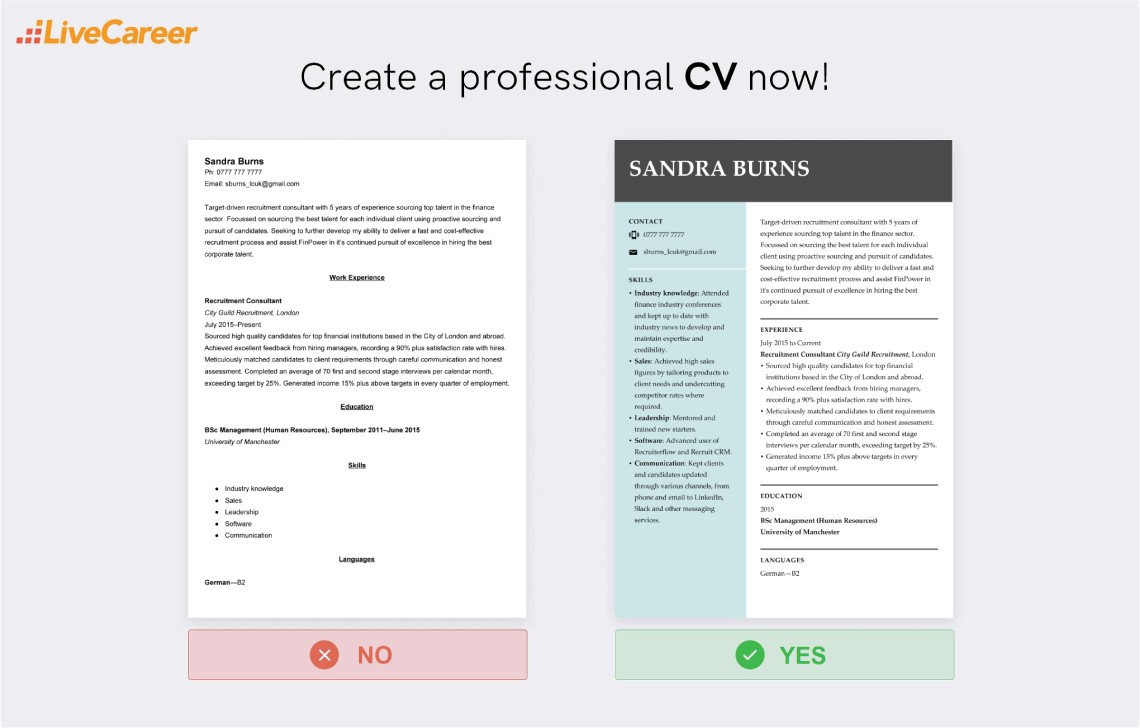![IT CV Examples for 2025 [+ How to Write]](https://cdn-images.livecareer.co.uk/pages/it_cv_lcuk_1.jpg?fit=crop&h=216&dpr=3)
IT CV Examples for 2025 [+ How to Write]
How to write an IT CV smarter than the newest technology? Check out our example IT CV, dedicated template, and ways to stand out from the pile of CVs.
Our customers were hired by:
We all know what a CV needs to contain. Relevant experience and education, stand out skills and impressive professional achievements are the key to success. But they won’t do any good unless you incorporate them into the right CV structure.
A good CV structure is essential to frame your content and present it in a logical format. Recruiters are busy and they expect to find the information they need fast. In a few minutes, you'll learn how to set out a CV that gives them everything they look for.
In this guide, you'll find a CV structure example for reference, plus, detailed instructions on how to structure a CV the right way. Get the UK CV structure that fits standards and look no further.
Create an effective CV in minutes. Choose a professional CV template and fill in every section of your CV in a flash using ready-made content and expert tips.

We created the sample on the right using our builder. See other good CV examples like this one.
Looking for other guides on CV writing?
Sandra Burns
Ph: 0777 777 7777
Email: sburns_lcuk@gmail.com
Target-driven recruitment consultant with 5 years of experience sourcing top talent in the finance sector. Focussed on sourcing the best talent for each individual client using proactive sourcing and pursuit of candidates. Seeking to further develop my ability to deliver a fast and cost-effective recruitment process and assist FinPower in it’s continued pursuit of excellence in hiring the best corporate talent.
Work Experience
Recruitment Consultant
City Guild Recruitment, London
July 2015–Present
Education
BSc Management (Human Resources), September 2011–June 2015
University of Manchester
Skills
Languages
Now you know how a well-structured CV looks like. Here’s how to set out your CV the same way.
The most commonly used CV structure is known as a chronological CV. It’s the best choice for most candidates and the structure that hiring managers have come to expect as standard. It’s easy to read, concentrates on your work experience, and is fully compatible with the ATS software companies use to scan your application.
And now, let’s take a look at each section from top to bottom so you can see exactly how to go about creating the perfect CV structure.
Start off at the top of the page with a CV header. It’s the section that contains your name and personal details. Include your full name in a CV font 6–8 pts larger than the body text for emphasis. Think of it as your personal ‘brand’, it needs to stand out. Then include your job title, phone number, email address and a link to your LinkedIn profile.
Optionally, you can include links to social media profiles if relevant but there’s no need to include your postal address. It’s an unnecessary waste of space, and every line counts, especially if you’re trying to structure a one-page CV.
Sandra Burns
Ph: 0777 777 7777
Email: sburns_lcuk@gmail.com
A strong CV summary will convince the recruiter you’re the perfect candidate. Save time and choose a ready-made personal statement written by career experts and adjust it to your needs in the LiveCareer CV builder.

This section also goes by the name of CV profile or personal statement. But they all mean exactly the same thing. A short paragraph, 3–5 lines long that introduces you and summarises your strengths as a candidate. Make it attention grabbing and impactful. The idea is to introduce yourself in such a way that the hiring manager can’t help but want to find out more.
And you may find the first part of your CV structure easier to write if you leave it until last. Having the rest of your content already written makes it much simpler to create a summary of it.
Personal Statement
Target-driven recruitment consultant with 5 years of experience sourcing top talent in the finance sector. Focussed on sourcing the best talent for each individual client using proactive sourcing and pursuit of candidates. Seeking to further develop my ability to deliver a fast and cost-effective recruitment process and assist FinPower in it’s continued pursuit of excellence in hiring the best corporate talent.
This is the linchpin of your CV structure and the section that recruiters pay the most attention to. List your work history in reverse chronological order. Include the same basic info for each entry, citing your job title, the name of the employer and your dates of employment.
Then write up to six bullet points for each job listed. Start them with punchy CV action verbs and strengthen your CV structure by writing them as accomplishment statements.
Work Experience
Recruitment Consultant
City Guild Recruitment, London
July 2015–Present
Here’s where the structure of a CV doesn’t have to be completely rigid. In a CV structure for students who often write their first CVs, school-leavers and recent graduates you can put your education section before your work experience. When you lack a significant work history your education holds more relevance.
But regardless of where you put this section it still needs the same information. If you’re a university graduate or student, mention the name of your degree, the start and end dates of your studies and the name of your university. Use an expected graduation date if you’re still studying.
For school leavers, include the name of the school or college you attended, the A-level subjects you completed and your dates of study. Including your GCSEs isn’t strictly necessary, unless you’re still at school or have just left. But if you do include them you only need to list Maths and English specifically. Mention the number of subjects you studied to account for the rest.
Education
BSc Management (Human Resources), September 2011–June 2015
University of Manchester
How to structure a CV skills section? The temptation is just to throw in some buzzword type abilities and hope for the best. But it’s much more effective to take a targetted approach. Your entire CV structure, including your skills section, should be tailored to the job you’re applying for.
Read the job advert carefully and make a list of the skills that are mentioned. Then list your own skills and include those that match up with the job requirements, 5–10 is an ideal number. Make sure you include a good mix of soft skills and hard skills.
And while you should always write a targetted skills list, some abilities are useful in almost any job. IT skills and communication skills are a great choice for any candidate.
Skills
If you finish with your skills section then you’ve got the bare minimum needed for an effective CV structure. But in a competitive job market, the bare minimum simply won’t do. That’s why we recommend you include extra sections to distinguish yourself from other candidates.
Consider including languages, awards, volunteering, projects and hobbies and interests. If it’s relevant and adds value it’s worth including. Volunteering in particular is an underappreciated addition to your CV. In fact, one survey revealed that a full 64% of recruiting decision-makers viewed volunteering as an important addition to a CV.
Languages
There’s one other type of CV structure in the UK, and it’s known as a functional or skills-based CV. It’s much less popular and it can only be used successfully by a limited group of candidates. These include freelancers and gig-based workers, military transitioners and people writing a career change CV.
If you do fall into any of the categories mentioned above, we’d recommend taking a look at our guide on how to write a skills-based CV.
A professional CV structure isn’t just about the order of sections. It’s also about the overall presentation and CV layout. Here’s how to set out a CV to keep it sharp:
And that’s it. Follow this advice and you’ll have the best CV structure possible for impressing hiring managers and winning interviews.
You don’t have to be a CV writing expert. In the LiveCareer CV builder you’ll find ready-made content for every industry and position, which you can then add with a single click.

Thanks for reading. If you want to know more about creating an effective CV writing structure, or if you have more questions about how to structure a UK CV then please ask in the comment section. We’ll be happy to help.
Our editorial team has reviewed this article for compliance with Livecareer’s editorial guidelines. It’s to ensure that our expert advice and recommendations are consistent across all our career guides and align with current CV and cover letter writing standards and trends. We’re trusted by over 10 million job seekers, supporting them on their way to finding their dream job. Each article is preceded by research and scrutiny to ensure our content responds to current market trends and demand.
About the author
Since 2013, the LiveCareer UK team has shared the best advice to help you advance your career. Experts from our UK editorial team have written more than one hundred guides on how to write the perfect CV or cover letter.
Rate this article:
Cv structure
Average:

![IT CV Examples for 2025 [+ How to Write]](https://cdn-images.livecareer.co.uk/pages/it_cv_lcuk_1.jpg?fit=crop&h=216&dpr=3)
How to write an IT CV smarter than the newest technology? Check out our example IT CV, dedicated template, and ways to stand out from the pile of CVs.

How to write a professional project manager CV that is up to the task? Check our 8 project manager CV examples and templates for all seniority levels.

How to write a graphic design CV? Check our graphic designer CV examples, personal statement writing tips, and ways to stand out from the pile of CVs.
Our customers were hired by: